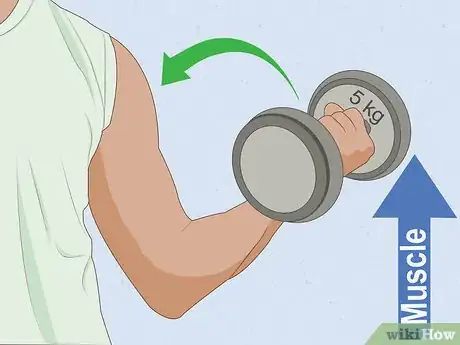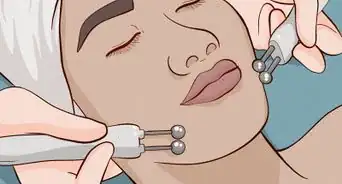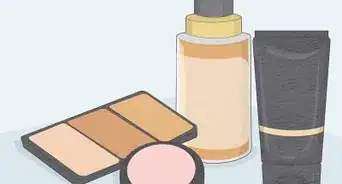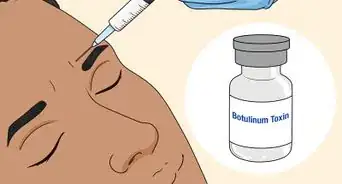This article was medically reviewed by Adebola Dele-Michael, MD, FAAD. Dr. Adebola Dele-Michael is a Board Certified Dermatologist and the Owner of Radiant Skin Dermatology and Laser, PLLC in Manhattan, New York. With over 12 years of experience, she specializes in general and cosmetic dermatology, specifically, using lasers and energy devices in treating skin of color.She is an assistant professor of Dermatology at The Icahn School of Medicine at Mount Sinai in Manhattan, NYC. Dr. Dele-Michael holds a BS in Biochemistry from Stony Brook University and an MD from The University of Rochester School of Medicine and Dentistry. She completed her Dermatology Residency at Wayne State University School of Medicine, where she was also chief resident.
There are 26 references cited in this article, which can be found at the bottom of the page.
This article has been viewed 42,648 times.
Whether you have lost significant weight or simply worry about aging, you can keep your skin firm and tight with a few lifestyle changes. While it may not be possible to completely prevent loose skin, you can reduce the appearance or severity of the condition. If you have a more extreme case, you can even see a doctor for medical treatments.
Steps
Keeping Skin Firm
-
1Eat a healthy, well-balanced diet high in protein and antioxidants. Eat fresh vegetables, fruits, whole grains, and lean meats instead of processed foods. Protein contains collagen and elastin, which both make your skin firm.[1] Antioxidants, meanwhile, can help heal aging caused by sun damage.[2]
- Good sources of protein include eggs, dairy, beans, tofu, seeds, and fish.
- Antioxidants like Vitamin C, Vitamin A, and biotin (Vitamin B7) are found in fruits and vegetables, such as tomatoes, carrots, oranges, and leafy greens. You can also take supplements, although your body may absorb them better from food.[3]
- Lean meats, like turkey, chicken, and fish, are a good source of both protein and antioxidants like selenium.[4]
- For example, you might eat scrambled eggs and an orange for breakfast, a spinach salad and cottage cheese for lunch, and grilled salmon with salsa for dinner.
-
2Drink plenty of water every day. Water will keep your skin elastic and plump. Men should drink about 15.5 cups (3.7 l) and women should drink about 11.5 cups (2.7 l) of water per day.[5] To make sure you get enough water, carry a bottle with you throughout the day.
- Remember to drink water both before and after exercising.
- If you're dehydrated, your body loses both water and electrolytes, both of which can help keep your skin tight and smooth. Try eating a banana with a glass of water for a healthy boost in electrolytes. Do not drink sports drinks, which are high in sugar.[6]
Advertisement -
3Exfoliate your skin. Exfoliation can improve circulation, which may keep your skin healthy and firm. In the shower, scrub your body with exfoliating gloves or a boar brush. For your face, use a facial scrub after washing it with a cleanser.[7]
- Ask your doctor for a referral to a dermatologist or look for one through the American Academy of Dermatology: https://www.aad.org/find-a-derm.
- Exfoliating too often can cause skin damage. Start by exfoliating once a week. After a few months, you can exfoliate 2 or 3 times a week.
- For more dramatic results, visit your dermatologist for a chemical peel or microdermabrasion. These should only be done once every few months.[8]
-
4Quit smoking. Smoking may make your skin less elastic, contributing to looser skin. If you are a smoker, talk to your doctor about quitting. Your doctor may recommend a nicotine patch or medication to help you quit.[9]
Plumping Skin During Weight Loss
-
1Lose weight slowly. If you lose too much weight at once, you might have more excess skin than you would if you lost weight slowly. Aim to lose no more than 1–2 pounds (0.45–0.91 kg) per week.[10]
- To lose 1 pound a week, you must burn 3,500 calories a week. You can reach this goal by cutting out 500 calories from your diet every day.
-
2Keep your total body fat between 14-22%. This is a healthy range of body fat. Keeping a little bit of fat on the body will help plump up any skin left over from weight loss. Visit a doctor or personal trainer to learn your body fat percentage.[11]
-
3Build muscle to fill out skin. Building muscle will also improve your chances of losing more weight. To build muscle most efficiently, you can either do fewer reps with heavier weights or more reps with lighter weights.[12]
- Good weight lifting moves include deadlifts, bench presses, and bicep curls.
- Body weight exercises can also be useful. You can do crunches, leg lifts, and flutter kicks.
Preventing Signs of Aging
-
1Wear sunscreen with at least 30 SPF every day. Apply the sunscreen to your face and body 15 minutes before going outside. Reapply after 2 hours of sun exposure. To provide extra protection against the sun, wear a hat with a brim. Avoid spending too much time outside between 10 am and 3 pm, when the sun is the brightest.[13]
-
2Apply a moisturizer to your face and neck twice a day. Moisturizing is essential to keep skin firm and smooth as you age. Put on a cream or gel every morning and night after you wash your face.[14] Look for moisturizing ingredients, such as:
-
3Massage body lotion into the rest of your body daily. You do not need to moisturize your body as often as your face, but it will keep the skin around your stomach, arms, legs, buttocks, and back tight and smooth. Look for lotions with Vitamins A, B5, C, or E.[21]
- Oils and butters, like avocado oil or shea butter, are also great ingredients for your skin.
- The best time to put on body lotion is right after a shower because hot water can strip your skin of its natural oils. Apply the lotion over your arms, stomach, legs, and back while your skin is still slightly damp.[22]
-
4Do facial exercises to reduce jowls. Some facial exercises may be able to prevent sagging skin around your face.[23] Do these exercises every day after you have applied moisturizer. The moisturizer will prevent you from pulling or tugging your skin.[24]
- To exercise your jaw, smile without moving your cheeks. Hold it for a few seconds, then release. Do this 10 times. Once you get good at it, you can try just smiling with one side of your mouth.
- To massage your cheeks, smile as broadly as you can. Then place your fingers on the tops of your cheekbones. Push down for 10 seconds before releasing. Do this 5 times.
- To prevent neck wattle, hold your neck straight and lean back your head as far as it will go. Once you are in this position, try placing your lower lip over your upper lip. Or, say the letters “O” or “E.” Hold this for 10 seconds. Repeat once a day.
Getting Medical Treatment
-
1Visit a dermatologist to talk about laser skin tightening. Laser treatments make your skin contract around your face, leading to a tighter appearance. Laser treatments can also boost collagen and elastin fibers in the skin. You may need to get 2 or 3 treatments about a month apart to see results. Find a local dermatologist who offers laser treatments to get a consultation.[25]
- Laser treatments can cost anywhere from $500 to $3,500. Your dermatologist may charge per session.
-
2See a plastic surgeon to prevent a saggy neck. Liposuction and Botox can both be used on your neck to prevent loose folds from developing. If you want a non-surgical option, you may be able to get ultrasound treatments to firm up your neck. A plastic surgeon will be able to walk you through your options.[26]
- Neck liposuction usually costs between $2,000 to $4,000.
- Botox treatments usually cost between $350 to $500.
- Ultrasound therapies, such as Ultherapy, can cost anywhere from $2,500 to $5,000.
-
3Plan for body contouring if you want to lose a significant amount of weight. If you will be losing more than 50 pounds (23 kg), understand that you may have loose skin afterwards. While little can be done to stop this, you may get body contouring surgery (sometimes known as a tummy tuck) afterwards to remove the skin. Start talking to your doctor early if you worry this will be an issue for you.[27]
- It can cost up to $30,000 to contour the entire body. Insurance sometimes covers the surgery, as extra skin can carry health risks, but not always. You may want to start saving money just in case.
- You may not be allowed to get body contouring until you have maintained your weight for at least 6 months.
Expert Q&A
-
QuestionHow do you keep skin tight when losing weight?
 Adebola Dele-Michael, MD, FAADDr. Adebola Dele-Michael is a Board Certified Dermatologist and the Owner of Radiant Skin Dermatology and Laser, PLLC in Manhattan, New York. With over 12 years of experience, she specializes in general and cosmetic dermatology, specifically, using lasers and energy devices in treating skin of color.She is an assistant professor of Dermatology at The Icahn School of Medicine at Mount Sinai in Manhattan, NYC. Dr. Dele-Michael holds a BS in Biochemistry from Stony Brook University and an MD from The University of Rochester School of Medicine and Dentistry. She completed her Dermatology Residency at Wayne State University School of Medicine, where she was also chief resident.
Adebola Dele-Michael, MD, FAADDr. Adebola Dele-Michael is a Board Certified Dermatologist and the Owner of Radiant Skin Dermatology and Laser, PLLC in Manhattan, New York. With over 12 years of experience, she specializes in general and cosmetic dermatology, specifically, using lasers and energy devices in treating skin of color.She is an assistant professor of Dermatology at The Icahn School of Medicine at Mount Sinai in Manhattan, NYC. Dr. Dele-Michael holds a BS in Biochemistry from Stony Brook University and an MD from The University of Rochester School of Medicine and Dentistry. She completed her Dermatology Residency at Wayne State University School of Medicine, where she was also chief resident.
Board Certified Dermatologist Talk to your dermatologist about skin-tightening treatments done using lasers and energy devices. You could also ask your dermatologist injecting fillers into your skin, which can replace some of the volume that's been lost during your weight loss.
Talk to your dermatologist about skin-tightening treatments done using lasers and energy devices. You could also ask your dermatologist injecting fillers into your skin, which can replace some of the volume that's been lost during your weight loss. -
QuestionWill you have loose skin after losing 30 pounds?
 Adebola Dele-Michael, MD, FAADDr. Adebola Dele-Michael is a Board Certified Dermatologist and the Owner of Radiant Skin Dermatology and Laser, PLLC in Manhattan, New York. With over 12 years of experience, she specializes in general and cosmetic dermatology, specifically, using lasers and energy devices in treating skin of color.She is an assistant professor of Dermatology at The Icahn School of Medicine at Mount Sinai in Manhattan, NYC. Dr. Dele-Michael holds a BS in Biochemistry from Stony Brook University and an MD from The University of Rochester School of Medicine and Dentistry. She completed her Dermatology Residency at Wayne State University School of Medicine, where she was also chief resident.
Adebola Dele-Michael, MD, FAADDr. Adebola Dele-Michael is a Board Certified Dermatologist and the Owner of Radiant Skin Dermatology and Laser, PLLC in Manhattan, New York. With over 12 years of experience, she specializes in general and cosmetic dermatology, specifically, using lasers and energy devices in treating skin of color.She is an assistant professor of Dermatology at The Icahn School of Medicine at Mount Sinai in Manhattan, NYC. Dr. Dele-Michael holds a BS in Biochemistry from Stony Brook University and an MD from The University of Rochester School of Medicine and Dentistry. She completed her Dermatology Residency at Wayne State University School of Medicine, where she was also chief resident.
Board Certified Dermatologist You might! Fat has a way of cushioning the skin and making it taut—that's why dermatologists sometimes recommend fillers for loose skin due to weight loss. They help fill in some of the lost volume that's causing the skin to sag.
You might! Fat has a way of cushioning the skin and making it taut—that's why dermatologists sometimes recommend fillers for loose skin due to weight loss. They help fill in some of the lost volume that's causing the skin to sag.
References
- ↑ https://www.ncbi.nlm.nih.gov/pubmed/23949208
- ↑ https://www.sciencedirect.com/science/article/pii/S0923181110000782
- ↑ https://www.webmd.com/beauty/features/its-not-your-mothers-skin-or-is-it/
- ↑ https://www.diabetes.co.uk/food/lean-meat.html
- ↑ https://www.mayoclinic.org/healthy-lifestyle/nutrition-and-healthy-eating/in-depth/water/art-20044256
- ↑ http://www.dermascope.com/ingredients/the-role-of-electrolytes/
- ↑ http://www.newhealthadvisor.com/how-to-avoid-loose-skin.html
- ↑ https://www.ncbi.nlm.nih.gov/pmc/articles/PMC3583892/
- ↑ https://www.mayoclinic.org/diseases-conditions/wrinkles/symptoms-causes/syc-20354927
- ↑ http://www.newhealthadvisor.com/how-to-avoid-loose-skin.html
- ↑ https://www.mensfitness.com/weight-loss/burn-fat-fast/best-workout-tighten-loose-skin
- ↑ https://www.sciencedaily.com/releases/2016/07/160712094259.htm
- ↑ https://www.mayoclinic.org/diseases-conditions/wrinkles/symptoms-causes/syc-20354927
- ↑ https://www.ncbi.nlm.nih.gov/pmc/articles/PMC4885180/
- ↑ https://www.ncbi.nlm.nih.gov/pubmed/17026654
- ↑ https://www.ncbi.nlm.nih.gov/pmc/articles/PMC3583886/
- ↑ https://www.ncbi.nlm.nih.gov/pmc/articles/PMC2705153/
- ↑ https://www.ncbi.nlm.nih.gov/pubmed/19159387
- ↑ https://www.ncbi.nlm.nih.gov/pmc/articles/PMC4976416/
- ↑ https://www.ncbi.nlm.nih.gov/pubmed/23438139
- ↑ https://www.utmedicalcenter.org/healthy-tips/103/the-importance-of-moisturizing/
- ↑ https://www.ncbi.nlm.nih.gov/pmc/articles/PMC4885180/
- ↑ https://www.ncbi.nlm.nih.gov/pmc/articles/PMC4190816/
- ↑ https://bellatory.com/skin/Facial-Exercise-The-Natural-Facelift-That-Will-Make-You-Look-Years-Younger-Just-10-Minutes-A-Day
- ↑ https://www.docshop.com/education/dermatology/facial/skin-tightening
- ↑ http://www.nytimes.com/2010/12/23/fashion/23Neck.html
- ↑ https://www.mayoclinic.org/tests-procedures/tummy-tuck/details/why-its-done/icc-20231152










































































